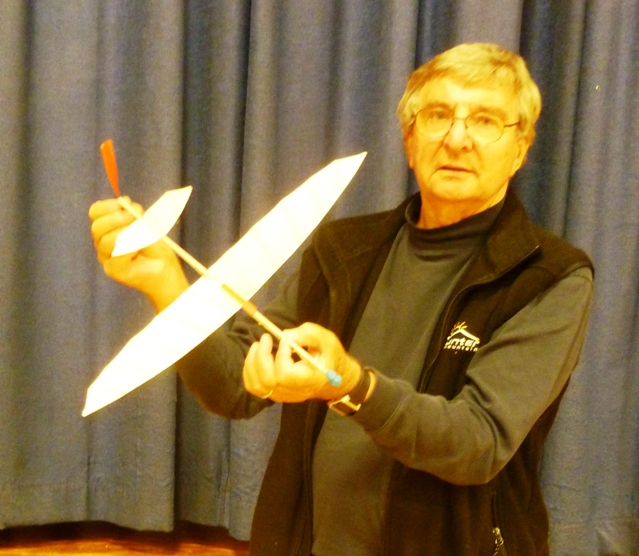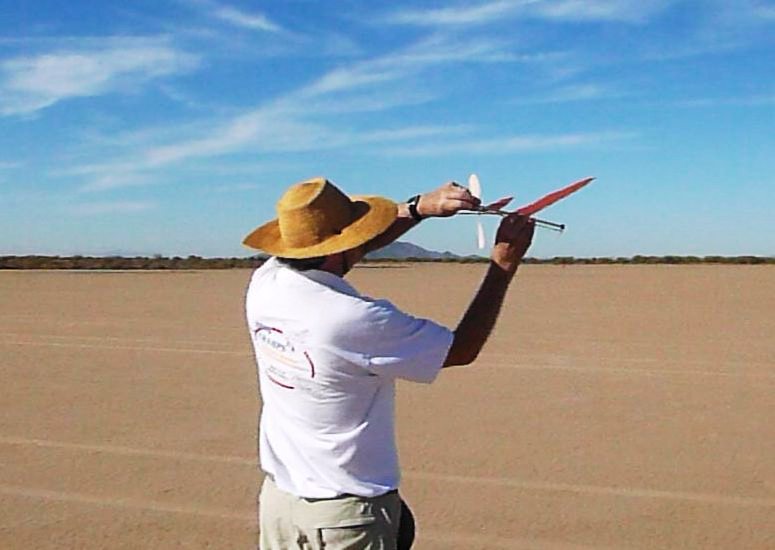
Yet another Aeronautical Challenge
For the last ten years I have been competing in the RC events at the Southwest Regionals SAM contest in Eloy Arizona, about half way between Phoenix and Tucson. Anyway, I just heard they are holding a special free flight event this year for Alphonse Penuad's Planophore model. They published the rules on their website.
Alphonse Penaud is credited with the first successful model airplane flight when he flew his rubber powered Planophore model over a distance of 131 feet in 11 seconds in 1871 at the Tuileries Garden in Paris.

There is a good deal of information on Penaud and his flying machines on the internet and one clean plan, although I don't know its history.

When I expressed interest in the event on the SAM chat group Greg Tutmark from SAM 8 in Seattle and the sponsor of the event, told me he built one but couldn’t trim it into stable flight. He said he thought it might be the pusher propeller. I told him pusher props are stabilizing; he was not amused!

As further interest was shown for the event some conversations took place regarding the rules which require the use of period materials, particularly aluminum. Along the line Gary Hinze posted an Alphonse Penaud's original description of his work published in French and translated by Gary.
OK, so I want to compete; what to do? Yikes, just realized it is our first indoor meet this evening, an ideal place to try something like this. So thinking I was only building a proof of concept model (even though it had been already proven 142 years ago). It would be easy if I could make it from solid balsa and use some of the parts from one of those dime store all balsa rubber models; I have the parts. So I built it in a few hours before the meet.

The wings and tail were made from 1/32 inch sheet balsa formed to shape over a bucket and held in place by gluing Kevlar thread to the upper curved surface. Seemed to work fine, and by inserting only the forward portion of the wing into the plastic mount I achieved adequate wing incidence and decalage for the flight testing starting point.


I flew it late in the evening. At first it was way tail heavy due to the plastic prop, but adding more and more modeling clay to the nose brought it into trim and I achieved two magnificent flights. Aero design proved.

Subsequent discussions with Greg revealed suggestion that he received from Al Lidberg, long time free flight competitor and Contest Manager for the Southwest Regionals, to add downthrust. Sure enough, my model with the dime store prop has downthrust, well, upthrust actually, but the effect is the same.
Now to build a proper one with all the original materials, balsa, bamboo, piano wire, tissue paper and cotton thread and do some more testing before launching off to Arizona.
I decided to build rugged rather than very light weight because at the contest there would be no "long grass" to support out of trim test flying, and it would probably take many flights to trim then put in official times. Furthermore, the rules state the model must be flightworthy following the official flights!
So my first decision was to laminate the wing leading edge from three layers of thin bamboo, planed from window shade stock. This worked quite well so I decided to make the cambered ribs from laminations too; two layers of 1/32 balsa. Same for the tail leading edge too.

For covering I decided to use straight jap tissue without further surface coating but when the trailing edge turned out a bit floppy I added a cotton thread fastened to the ribs and covering with a lick of full strength nitrate dope.
Next the propeller. Experience shows that most props, when properly sorted to the model, end up with a pitch / diameter ratio of one. The rules stipulated a maximum diameter of eight inches so and eight x eight it would be. I decided to make a laminated three layer 1/32 balsa blade formed over a suitable tube. Fortunately I had done the math years ago so the layout was easy. During the layup I decided to add a layer of the jap tissue to increase the cross grain strength although I also slightly skewed the layup of the middle layer too. The blades came out fine and I made a simple assembly jig to attach blades to the bamboo skewer center piece.
The final tricky bit of design and construction was to mount the prop in such a way as to allow changes to the downthrust (upthrust!). This I did with a .005 inch brass shim fabrication; aluminum was not allowed by the rules as although it was available at the time it was very precious and would clearly not fit the spirit of the rules. The following two pictures are devoid of the locking pin as they were taken after the contest when I lost the pin and just glued the fitting in place.
Finally, based on prior experience including the successful "proof of concept" model, I arranged for the wing to be mounted with a positive incidence directly on the fuselage motor stick.
Of course I needed to transport the model to California and thence to Arizona so I decided not to assemble it until the contest, so the parts were carefully mounted in an old kit box which in turn was shipped with my other model in my trusty hard sided golf bag; with a special note to the Transportation Security Authority imploring them no to smash it as they usually do!
Fortunately the box arrived undamaged and I had one more task before assembly; I needed a thrust washer. Fortunately, well not fortunately, but rather as expected SoCal eating, drinking and flying buddy Mike Myers had a box full of possibilities so I selected one of the right diameter and proceeded to complete the assembly. I had brought some rubber of various sizes and a winder. I also borrowed some rubber lube from Mike, so we were set for the long but interesting drive from LA to Eloy. Well, not interesting to the locals but my wife and I can't get enough of the Western Desert scenery, and the drive from LA to Eloy has it in spades!
The weather forecast for the weekend was for excellent conditions; cold in the early mornings but rising to the mid 70s with sun and modest winds. Interestingly enough, unlike the East Coast conditions with which we are familiar, the Western deserts experience different weather patterns. All weekend there was a modest wind in the morning slowly diminishing towards mid day then changing direction 180 degrees and picking up again. These conditions were indeed ideal for most flying but the Planophore was a bit of a different animal. I needed calm conditions if I were to adjust the flight trim for optimum, well, even satisfactory flight.
Indeed, the first two launches were either straight up then down or straight down into the dirt. So trim was adjusted with some nose weight, a hit and miss affair, literally, until a couple of successful flights were achieved. All this was done in the RC area, so I decided the trim was good enough to drive to the Free Flight area a few miles away and put in some contest flights. We were allowed unlimited flights over the three days with the top flight time counting. But would the model last beyond one or two flights? Time to find out.


Although considerable interest was expressed prior to the event only four or five actually brought models and were prepared to fly. Still, the challenge was there and we set about making some flights. Once again the outcome was way over the map; dive into or pitch up then into the dirt, but one magic flight came out of all this and I recorded a 25 second flight. Not much but more than twice Alphonse Penaud achieved! So I was in the book and received great support and encouragement from Greg, Al and the other competitors. So back to the RC contest and see if anyone could beat my time. Oh, with one prop fracture; easily fixed, the model remained intact and original condition. But would my high time flight hold for the weekend?
The next day we went back to assess the competition and try to improve our times; this time with rubber lube and an alternate three-strand motor. The "successful" flight seemed weak on power so I expected the lube to help but the three-strand certainly would. But with maybe another dozen or so flights all I succeeded with was to match the 25 seconds with a two-strand flight and with exciting aerobatics a three-strand flight.

SAM 8 member and old buddy, Colin Widdison, times. Steve Reilly photo
Clearly a great deal more performance was possible but I had lost the downthrust locking pin in the dirt and had to glue it in place for the subsequent flights. This was a particular drawback with the three-strand motor as the model climbed to maybe twenty feet or so and pitched over into a succession of loops before cruising a few turns near the ground. I had made no provision for aerodynamic adjustments to the wing and tail; clearly a mistake. And adding a small dab of weight to a wing tip achieved the turning flight in cruise but had no effect on the critical climb.
Surprisingly, well, by design? the model survived about twenty "launches" and "landings" without damage except for the one prop incident.
The other competitors were very supportive of my efforts on the final day awarded me the trophy, one I will cherish, at least until they ask for it back!
Here is event sponsor and manager Greg Tutmark congratulating me for the win.

And here is Contest Director Al Lidberg awarding me the superb trophy.


Challenge accepted and mission accomplished.